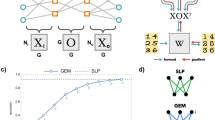Abstract
Recent studies in evolutionary computation have focused on using developmental processes together with genetic algorithms in order to achieve more complex designs. Although several models have been proposed, their growth dynamics, and their interactions with evolutionary algorithms are still poorly understood. One particularly neglected concept in artificial developmental systems is heterochrony: how evolution affects development by changing the timing and rate of developmental events. In this article we attempt to address this issue by analyzing heterochronic changes in a well-known artificial developmental model, the cellular encoding model, by using a previously developed heterochrony framework. We have conducted experiments by evolving networks to solve a Boolean problem, and analyzed heterochronic changes in both successful and unsuccessful runs. Our findings show that owing to its properties, the cellular encoding model strongly affects the developmental dynamics and the heterochronic changes that occur during evolution. Our experiments also show that hypermorphic changes (a kind of heterochronic occurrence) lead to greater evolvability in successful runs.
Similar content being viewed by others
Explore related subjects
Discover the latest articles, news and stories from top researchers in related subjects.References
KO Stanley R Mikkulainen (2003) ArticleTitleA taxonomy for artificial embryogeny Artif Life 9 IssueID2 93–130 Occurrence Handle10.1162/106454603322221487
Gruau F (1994) Neural network synthesis using cellular encoding and the genetic algorithm. PhD thesis, Laboratoire de la Informatique du Parallelisme, Ecole Normale Superieure de Lyon
Bongard J (2002) Evolving modular genetic regulatory networks. Proceedings of the IEEE 2002 Congress on Evolutionary Computation, Piscataway, vol 2, pp 1872–1877, IEEE Press, New York
CP Klingenberg (1997) ArticleTitleHeterochrony and allometry: the analysis of evolutionary change in ontogeny Biol Rev 73 79–123 Occurrence Handle10.1017/S000632319800512X
Cangelosi A (1999) Heterochrony and adaptation in developing neural networks. Proceedings of the Genetic and Evolutionary Computation Conference, vol 2, pp 1241–1248. Morgan Kaufmann, Los Actos
Matos A, Suzuki R, Arita T (2005) Evolution of development and heterochrony in artificial neural networks. Proceedings of the 10th International Symposium on Artificial Life and Robotics, Beppu, Oita, Japan, pp 635–638
P Alberch SJ Gould GF Oster et al. (1979) ArticleTitleSize and shape in ontogeny and phylogeny Paleobiology 5 296–317
F Gruau (1995) ArticleTitleAutomatic definition of modular neural networks Adaptive Behav 3 151–183 Occurrence Handle10.1177/105971239400300202
JR Koza (1992) Genetic programming: on the programming of computers by means of natural selection MIT Press Cambridge Occurrence Handle0850.68161
KL von Bertalanffy (1938) ArticleTitleA quantitative theory of organic growth Hum Biol 10 181–213
Author information
Authors and Affiliations
Corresponding author
About this article
Cite this article
de Matos, A., Suzuki, R. & Arita, T. Heterochrony and evolvability in neural network development. Artif Life Robotics 11, 175–182 (2007). https://doi.org/10.1007/s10015-007-0425-0
Received:
Accepted:
Published:
Issue Date:
DOI: https://doi.org/10.1007/s10015-007-0425-0




